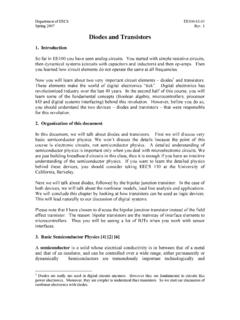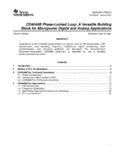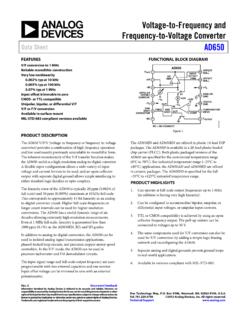Transcription of Radiation Tolerant Kintex UltraScale XQRKU060 FPGA Data …
1 DS882 ( ) December 17, Specification1 General DescriptionThe Radiation Tolerant (RT) XQR UltraScale architecture-based devices extend the benefit of commercial silicon with unique ceramic column grid array package, tested to stringent qualification flows like Xilinx class B, class Y test flows (QML compliant), full M-grade operating temperature range support, and Radiation tested for single-event Kintex UltraScale FPGAs are high-performance monolithic FPGAs with a focus on performance. High DSP and block RAM-to-logic ratios and next-generation transceivers combined with space-grade packaging to handle vibration and handling requirements during launch and operation enable a new generation of high-density FPGAs for on-orbit reconfiguration, targeted for applications like on-board processing, digital payloads, remote sensing, and many more.
2 The Xilinx Space Secure Site provides access to design guidelines and resources specific to space data sheet is part of an overall set of documentation on the UltraScale architecture-based devices available on the Xilinx website at of Radiation Characteristics for Kintex UltraScale XQRKU060 DevicesThis product is intended for use in space environments and offered in Xilinx class Y, class B manufacturing and process flows. Xilinx 20 nm UltraScale device technology is developed with innovative configuration memory and block RAM design for single-event upset (SEU) mitigation, with optimized SEU design rules and strategic implementation of SEU enhanced cells. The Kintex UltraScale XQRKU060 device uses more than 40 proprietary, patented circuit design and layout techniques to reduce the SEU cross-section.
3 Block RAM includes embedded error detection and correction (EDAC) for high-performance SEU Tolerant Kintex UltraScaleXQRKU060 FPGA Data SheetDS882 ( ) December 17, 2020 Product SpecificationTa b l e 1 : Radiation CharacteristicsSymbolDescriptionMinTypMa xUnitsTIDT otal Ionizing Dose (GEO)-100120 Krad (Si)SELS ingle-Event Latch-Up Immunity(1)-80-MeV-cm2/mgSEUCRAMS ingle-Event Upset in Configuration RAM (GEO)(2)(3) Upset in Block RAM (GEO)(2)(3) FeedbackRadiation Tolerant Kintex UltraScale XQRKU060 FPGA Data SheetDS882 ( ) December 17, Specification2 Weibull Fit ParametersWeibull curves were fitted to the measured test data. See the Radiation test summary data in the Radiation reports in the XQRKU060 area of the Xilinx Space Secure Site. A summary of the best fit Weibull parameters for the various components of the XQRKU060 FPGA is shown in Ta b l e Functional Interrupt Orbital Upset Frequency - Configuration RAM (GEO)(2)(3) : immunity at maximum recommended operating voltage and junction bar is 40% at 90% confidence estimate is based on CREME96 orbital models for worst-case conditions (solar minimum) and 100 mils of Al b l e 2 :Single Event Effect Type DescriptionsSingle Event Effect (SEE) TypeSEE SignatureTarget/CommentsSingle Event Upset (SEU)Corruption of the information stored in a memory elementMemories, latches in logic of single bit upset (SBU) or multiple bit upset (MBU).
4 Single Event Transient (SET)Impulse response of certain amplitude and durationAnalog and mixed-signal lead to SEU if latched in memory Event Latchup (SEL)High-current conditionsCMOS lead to hard Event Functional Interrupt (SEFI)Corruption of a datapath leading to loss of normal operationComplex devices with built-in state machine/control sections or b l e 3 :Weibull Fit ParametersParameterLETthWS satConfiguration Registers b l e 1 : Radiation Characteristics (Cont d)SymbolDescriptionMinTypMaxUnitsSend FeedbackRadiation Tolerant Kintex UltraScale XQRKU060 FPGA Data SheetDS882 ( ) December 17, Specification3 Kintex UltraScale XQRKU060 FPGA Feature SummaryDevice LayoutProgrammable resources in the XQRKU60 device are arranged in a column-and-grid layout.
5 Figure 1 shows a device-level view with resources grouped together. For simplicity, certain resources such as the integrated blocks for PCIe, configuration logic, and System Monitor are not b l e 4 : Kintex UltraScale XQRKU060 FPGA Feature SummaryFeatureQuantitySystem Logic Cells725,550 CLB Flip-Flops663,360 CLB LUTs331,680 Maximum Distributed RAM (Mb)9 Block RAM Blocks1,080 Block RAM (Mb)38 CMTs (1 MMCM, 2 PLLs)12I/O DLLs48 Maximum HP I/Os(1)516 Maximum HR I/Os(2)104 DSP Slices2,760 System Monitor1 PCIe Gen1/Gen2/Gen3 up to 8 lanes3 GTH Transceivers ( Gb/s)32 Notes: = High-performance I/O with support for I/O voltage from to = High-range I/O with support for I/O voltage from to Target - Figure 1 Figure 1:FPGA with Columnar ResourcesI/O, Clocking, Memory Interface LogicI/O, Clocking, Memory Interface LogicCLB, DSP, Block RAMCLB, DSP, Block RAMT ransceiversTransceiversCLB, DSP, Block RAMDS882_01_121418 Send FeedbackRadiation Tolerant Kintex UltraScale XQRKU060 FPGA Data SheetDS882 ( ) December 17, Specification4 Resources within the device are divided into segmented clock regions.
6 The height of a clock region is 60 CLBs. A bank of 52 I/Os, 24 DSP slices, 12 block RAMs, or 4 transceiver channels also matches the height of a clock region. The width of a clock region is essentially the same in all cases, regardless of the mix of resources in the region, enabling repeatable timing results. Each segmented clock region contains vertical and horizontal clock routing that span its full height and width. These horizontal and vertical clock routes can be segmented at the clock region boundary to provide a flexible, high-performance, low-power clock distribution architecture. Figure 2 is a representation of an FPGA divided into XQRKU060 device has I/O pins for communicating to external components. Each I/O is configurable and can comply with a large number of I/O standards.
7 The I/Os are classed as high-range (HR) or high-performance (HP). The HR I/Os offer the widest range of voltage support, from to The HP I/Os are optimized for highest performance operation, from to I/O pins are organized in banks, with typically 52 HP or HR pins per bank. Each bank has one common VCCO output buffer power supply, which also powers certain input buffers. In addition, HR banks can be split into two half-banks, each with their own VCCO supply. Some single-ended input buffers require an internally generated or an externally applied reference voltage (VREF). VREF pins can be driven directly from the PCB or internally generated using the internal VREF generator circuitry present in each Electrical CharacteristicsSingle-ended outputs use a conventional CMOS push/pull output structure driving High towards VCCO or Low towards ground, and can be put into a high-Z state.
8 The system designer can specify the slew rate and the output strength. The input is always active but is usually ignored while the output is active. Each pin can optionally have a weak pull-up or a weak pull-down signal pin pairs can be configured as differential input pairs or output pairs. Differential input pin pairs can optionally be terminated with a 100 internal resistor. The XQRKU060 device supports differential standards beyond LVDS, including RSDS, BLVDS, differential SSTL, and differential HSTL. Each of the I/Os supports memory I/O standards, such as single-ended and differential HSTL as well as single-ended and differential Target - Figure 2 Figure 2:Column-Based FPGA Divided into Clock RegionsClock Region WidthClockRegionHeightDS882_02_121418 For graphical representation only, does not represent a real FeedbackRadiation Tolerant Kintex UltraScale XQRKU060 FPGA Data SheetDS882 ( ) December 17, Specification53-State Digitally Controlled Impedance and Low Power I/O FeaturesThe 3-state digitally controlled impedance (T_DCI) can control the output drive impedance (series termination) or can provide parallel termination of an input signal to VCCO or split (Thevenin) termination to VCCO/2.
9 This allows users to eliminate off-chip termination for signals using T_DCI. In addition to board space savings, the termination automatically turns off when in output mode or when 3-stated, saving considerable power compared to off-chip termination. The I/Os also have low power modes for IBUF and IDELAY to provide further power savings, especially when used to implement memory LogicInput and Output DelayAll inputs and outputs can be configured as either combinatorial or registered. Double data rate (DDR) is supported by all inputs and outputs. Any input or output can be individually delayed by up to 1,250 ps of delay with a resolution of 5 15 ps. Such delays are implemented as IDELAY and ODELAY. The number of delay steps can be set by configuration and can also be incremented or decremented while in use.
10 The IDELAY and ODELAY can be cascaded together to double the amount of delay in a single and OSERDESMany applications combine high-speed, bit-serial I/O with slower parallel operation inside the device. This requires a serializer and deserializer (SerDes) inside the I/O logic. Each I/O pin possesses an IOSERDES (ISERDES and OSERDES) capable of performing serial-to-parallel or parallel-to-serial conversions with programmable widths of 2, 4, or 8 bits. These I/O logic features enable high-performance interfaces, such as Gigabit Ethernet/1000 BaseX/SGMII, to be moved from the transceivers to the SelectIO Serial TransceiversSerial data transmission between devices on the same PCB, over backplanes, and across even longer distances is becoming increasingly important. Specialized dedicated on-chip circuitry and differential I/O capable of coping with the signal integrity issues are required at these high data XQRKU060 FPGA has GTH transceivers.













